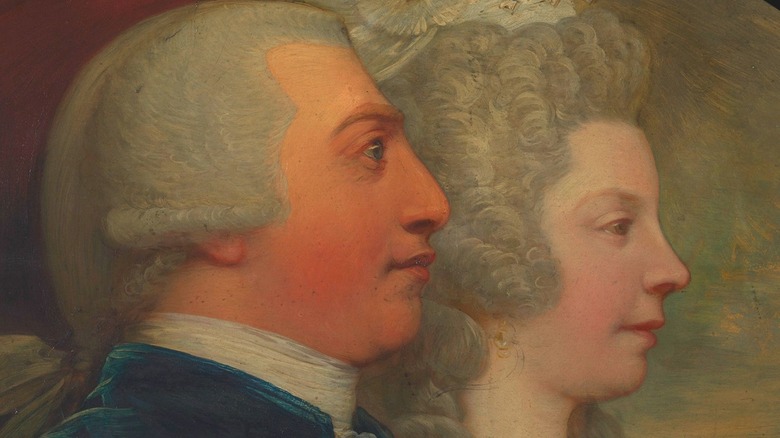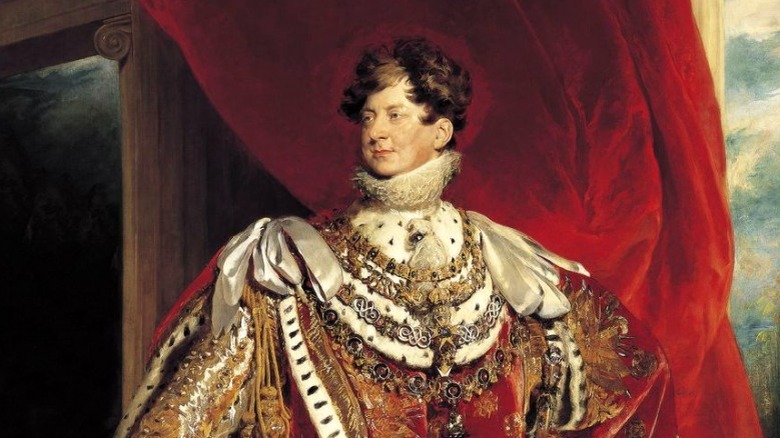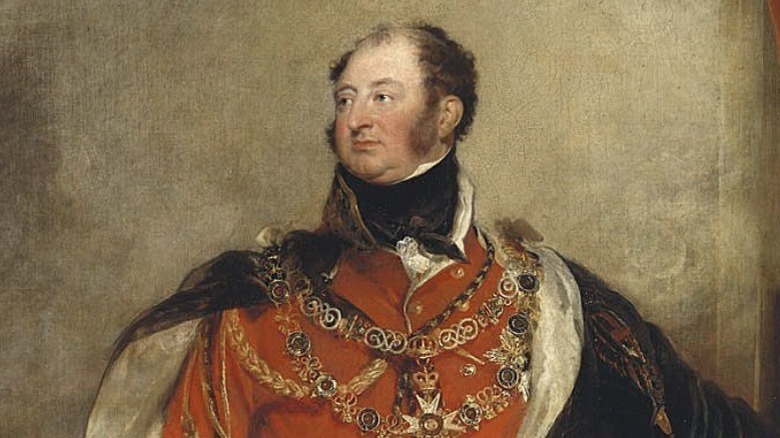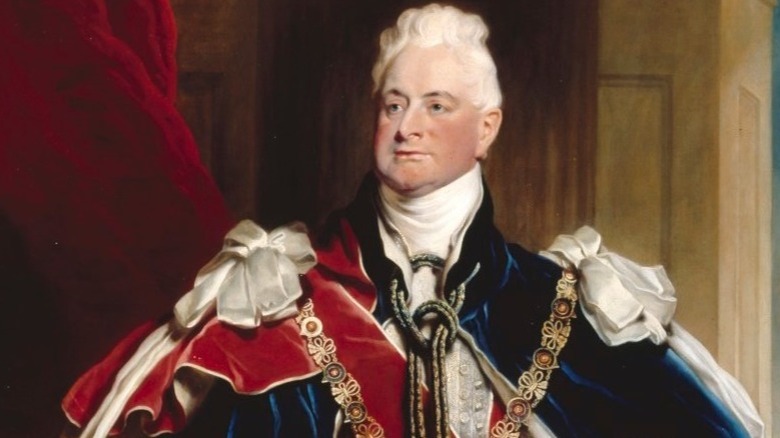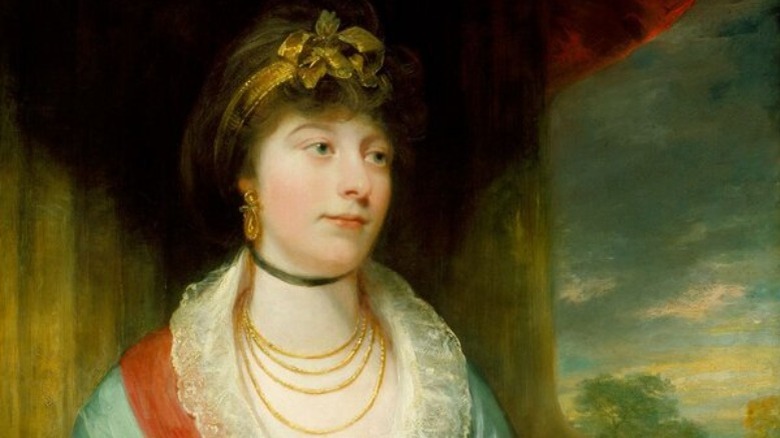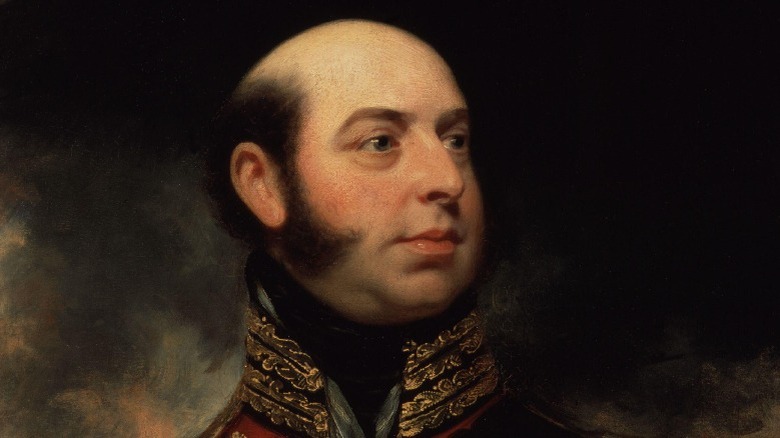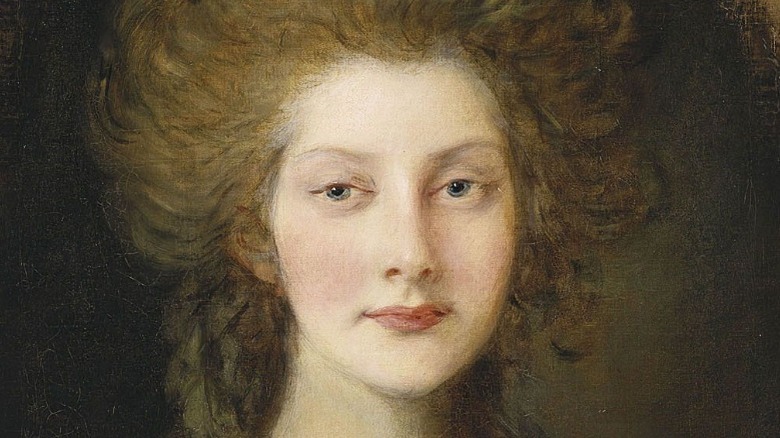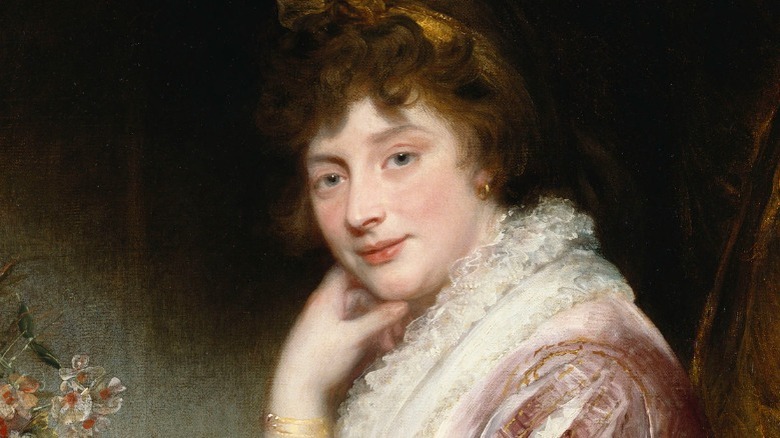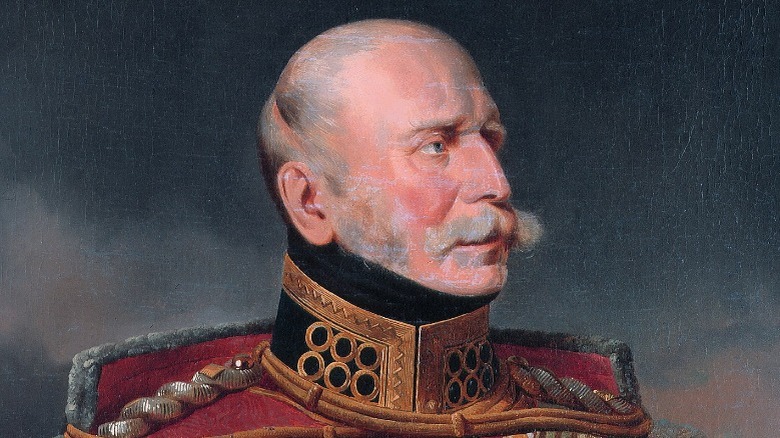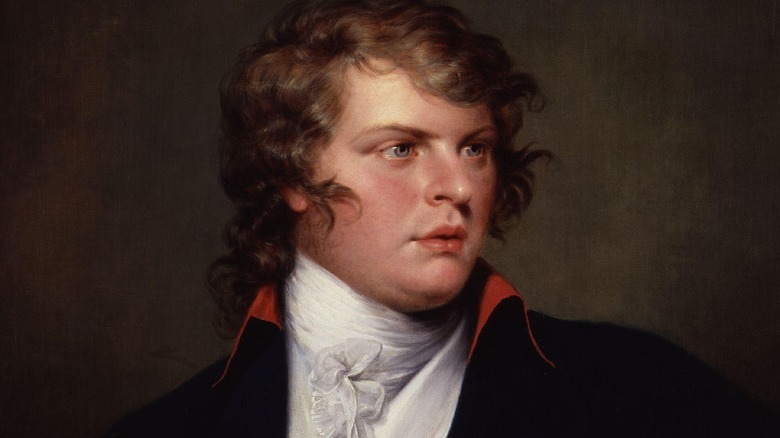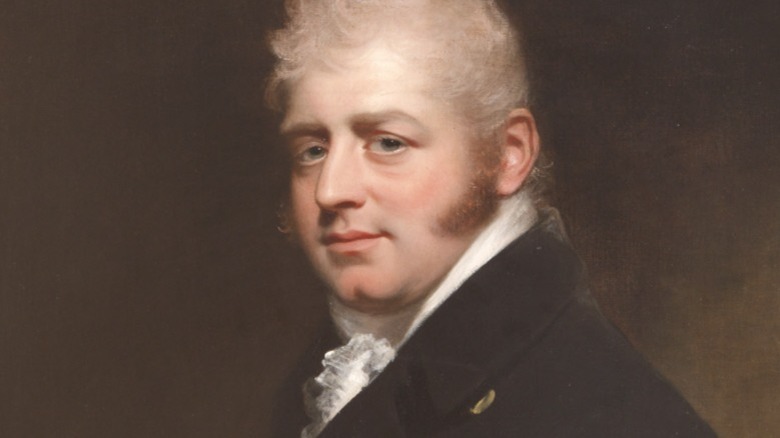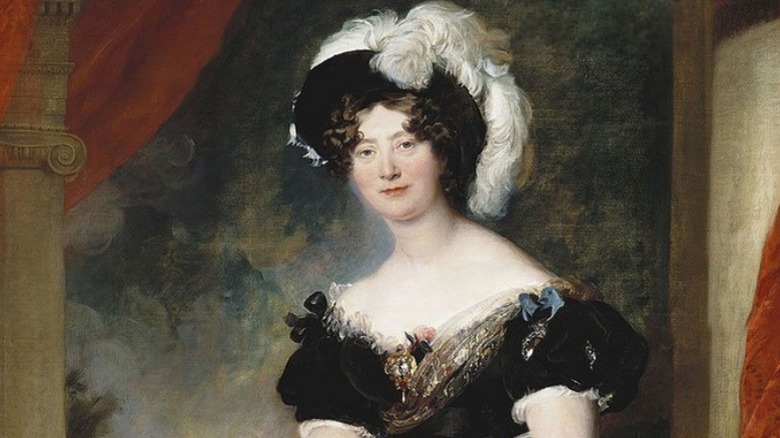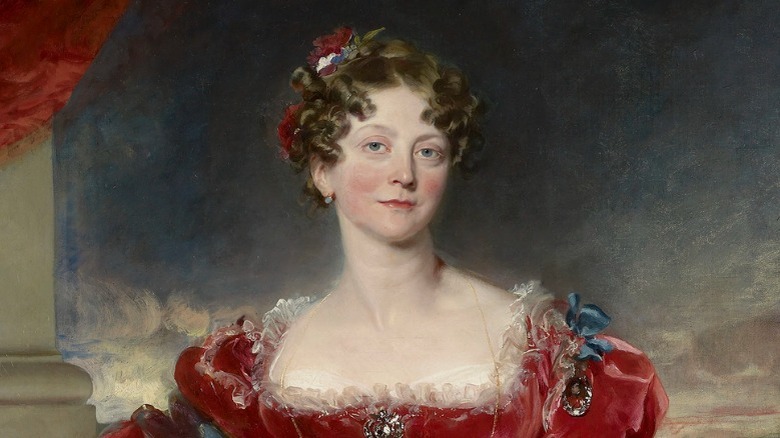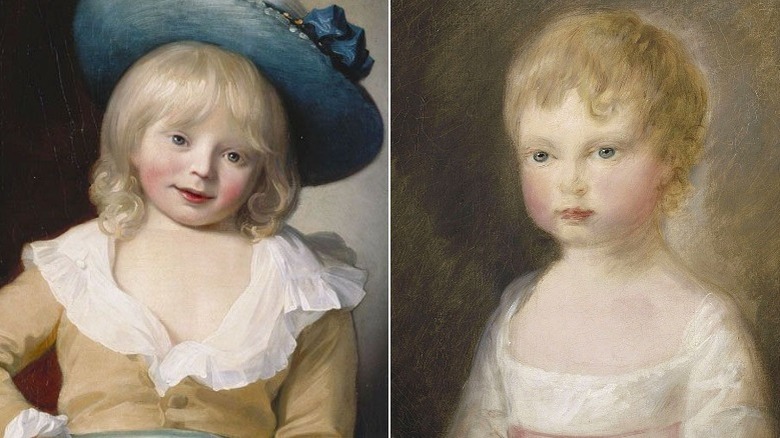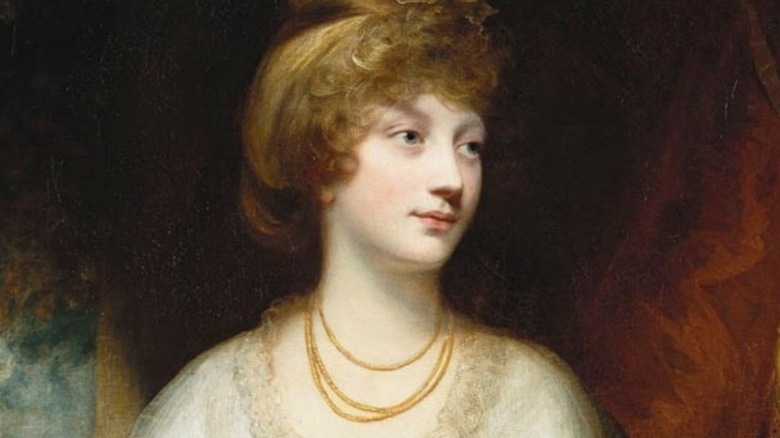Here's What Happened To King George III And Queen Charlotte's 15 Children
Before the creation of effective contraceptives, families could be really, really huge. Today a large family might be six or eight kids; back in the day double digits were a serious possibility — if the woman managed to survive all those births, that is.
George III, king of Great Britain from 1760 to 1820, is most famous for being on the throne when England lost its American colonies, and for eventually becoming mentally unstable in his later years. But also notable was his marriage to Princess Charlotte of Mecklenburg-Strelitz. King George and Queen Charlotte had never met before their wedding day, and she hadn't been his first choice of wife, but somehow their marriage really worked. It worked so well, in fact, that George III never took a mistress, unlike most kings. Of course, no mistress meant there was no one to share the bedroom fun-time responsibilities with. Long story short: Queen Charlotte gave birth to 15 children.
So what happened to all those kids? Some died young, some became kings, and all had very interesting lives.
George IV
Less than a year after they were married, King George III and Queen Charlotte welcomed their first child. Since it was a boy, and since three King Georges in a row were obviously not enough, they christened him George as well, and he would indeed go on to become George IV.
But George Jr.-Jr.-Jr. would end up taking over long before his dad died in 1820. By 1811, it was clear that the spells of mental instability that had come and gone earlier in George III's life were sticking around this time. His eldest son, then the Prince of Wales, was appointed regent for the next decade, per the Royal Family's official website.
George IV was nicknamed "Prinny," according to Westminster Abbey. He was obsessed with fashion, food, women, and alcohol. He also liked spending money, and Britannica explains that after living with a mistress for most of his adult life and having many illegitimate children, he agreed to marry someone appropriate only so Parliament would pay off his huge debts. Unfortunately, he and Princess Caroline of Brunswick hated each other from day one. Their wedding night produced their only child, and they lived apart after that. George died in 1830.
Prince Frederick, Duke of York and Albany
The second son of the monarch is traditionally styled the Duke of York, which is why that's Prince Andrew's title today. But while the modern Duke of York was stripped of his honorary military titles for being besties with Jeffery Epstein, Prince Frederick lost his role as Commander-in-Chief of the British Army in 1809 because it was discovered his mistress was selling commissions – meaning people paid her to make sure they got promoted. It's very likely Frederick was involved as well, although officially Parliament found he'd done nothing wrong, according to Britannica.
Since Frederick's older brother George couldn't bear the thought of doing his duty with his wife in order to shore up the line of succession with a bunch of kids, everyone was relying on George's only legitimate child, Princess Charlotte. When she died in childbirth in 1817, Frederick became his brother's heir. All Fredrick needed to do was outlive George and he'd be king — which he failed to do, dying in 1827.
Frederick had no children of his own since he didn't like his wife, Princess Frederica Charlotte of Prussia, either. The Royal Collection Trust says they lived separately soon after their marriage.
William IV
For most of his life, Prince William, Duke of Clarence and St Andrews, would have never expected to get anywhere near the throne. He had two older brothers, both of whom were before him in the succession, plus any children – male or female – they would have. But George and Frederick's distaste for their wives meant they only had one legitimate child between them, and when both his older brothers and his niece died before him, William became king in 1830.
Since he was considered very much a "spare" in the royal succession, Britannica records that at just 13 years old William joined the Royal Navy. He traveled the world and even fought in the American Revolution. The BBC says he absolutely loved being a sailor and was eventually promoted to Admiral of the Fleet.
After he retired in 1791, William came back to England and settled down with a mistress. Twenty years later, he left her and their 10 illegitimate children to marry Princess Adelaide of Saxe-Meiningen, per the Royal Family's official website. Despite four pregnancies, none of their children lived longer than 3 months. This meant when William died in 1837, he was succeeded by his niece, who would become the illustrious Queen Victoria.
Charlotte, Princess Royal
After three sons, George III and Queen Charlotte finally had a daughter in 1766, whom they named after her mother. According to "Princesses: The Six Daughters of George III," she was unofficially given the title "Princess Royal" at birth, before it was made official in her 20s. This is a title that can be given to any daughter of the monarch, but there can only be one at any time, and who gets it is based solely on the monarch's personal preference, although traditionally it goes to the eldest daughter.
George III was absolutely in love with his daughter. He made sure she got an education, spoke multiple languages, and spent a lot of time with him. However, his love for her (and for his subsequent daughters) would backfire on them: the Royal Collection Trust says that George really didn't want them to get married. Ever. He'd seen his sisters' disastrous marriages and couldn't bear to see his own girls end up as scorned and hated wives.
The spinster Charlotte would finally end up getting married at the age of 31 – the first of George III's daughters to do so – to the widowed Prince Friedrich of Württemberg. They had no children of their own, but the official site of Ludwigsburg Residential Palace records she got on very well with her stepchildren.
Edward, Duke of Kent and Strathearn
George III belonged to the House of Hanover, named after the electorate in modern-day Germany, which George I left when he was elevated to the British throne in 1714. In fact, George III was notable of the Hanoverian royals until that point in that English and not German was his first language, according to the official website of the Royal Family.
But the British royals still had a deep connection to their ancestral homeland. George III would even be crowned King of Hanover in 1814, although he never actually went there. But some of his children did, including Prince Edward, who moved there when he was 18 and enlisted as a cadet in the Hanoverian Foot Guards, per the Royal Collection Trust. The following year, he returned home to England and joined the British Army. Unfortunately, due to an incident of being absent without leave and his use of harsh discipline, Edward was sent to Canada by his father the king as punishment in 1791.
Perhaps unexpectedly for a royal, Edward was liberal for the time. His views that slavery was bad, Catholics had a right to worship as they wished, and the American colonies should have freedom if they wanted it were extremely radical. He was also the father of the future Queen Victoria, although he died in 1820, when she was less than a year old.
Princess Augusta Sophia of the United Kingdom
George III enjoyed having a daughter so much once Charlotte, Princess Royal was born that he was disappointed when their fifth child was another boy. According to "Princesses: The Six Daughters of George III," when Queen Charlotte was in the middle of labor with their sixth kid, the king told both her and the doctor he was going to be very upset if it wasn't a girl. Fortunately, Princess Augusta Sophia did not disappoint.
Augusta received an education like her older sister, although she could be a bit of a terror to her tutors, including one time she annoyed her teacher so much Augusta feared the woman might quit, so the princess wrote her an apology ... which she signed in blood.
Many people noted how beautiful Augusta was, and she received a handful of proposals from men who were acceptably important enough to marry a princess, the Royal Collections Trust records. But her father had to approve any offers of marriage, and he never did. Unlike her older sister, Augusta would remain single her whole life, although there is some evidence she had a secret relationship with an army general. She died in 1840, aged 71.
Princess Elizabeth of the United Kingdom
Born in 1770, Princess Elizabeth was remembered in her family as being a fat baby, and a chubby child. While that's adorable, her contemporaries didn't find it so. All the daughters of George III and Queen Charlotte were attractive, but Elizabeth was not considered the prettiest of the bunch, something it seems she was reminded of quite often. Fortunately, she had a "determined personality," according to "Princesses: The Six Daughters of George III," which helped her not care too much.
Princess Elizabeth was extremely artistic and found many ways to express this talent. The Royal Collection Trust records she gifted books of intricate paper cutouts to friends and designed decorative panels for one of the royal residences. They also note her drawings were so good that two series of engravings were published for sale to the public.
Elizabeth, like her sisters, suffered from the king's wish that they not get married. In 1818, two years before her father died and long after he lost the mental capacity to refuse, her brother the Prince Regent gave Elizabeth permission to marry Prince Friedrich of Hesse-Homburg. She was 48 years old at the time.
Ernest Augustus, King of Hanover
While women have always been able to succeed to the English throne, the same was not true in some other countries that used to have monarchies. France is a notable example of a place the monarch had to be a dude, and it gave us the term for it: Salic law. The Kingdom of Hanover was the same, which meant that in 1837, when William IV – also the then-King of Hanover – died, his successor Queen Victoria could not also ascend to the dynasty's Germanic throne. With his three other older brothers long dead, this meant Prince Ernest Augustus, Duke of Cumberland, got the crown and moved to Hanover.
No one in England missed him. Called "the most hated man" in the country, the Duke of Cumberland was a monster. In a review of "Queen Victoria: A Portrait," the Los Angeles Times writes that he murdered his valet and raped one of his sisters. (While there is no solid proof, both these accusations are extremely credible.) Unlike his brother Prince Edward, he didn't think Catholics should have the right to worship and fought hard to stop laws that would give them that freedom.
It's not surprising then that the National Portrait Gallery reports someone tried to assassinate the duke in 1810, or that he left England for an entire decade from 1818 to 1828. He died in 1851.
Prince Augustus Frederick, Duke of Sussex
The original Duke of Sussex was just as fascinating as the current one. Like his brother Prince Edward, Prince Augustus was openly for the abolition of slavery, but instead of just supporting the religious rights of Catholics, Augustus was even more controversially a supporter of the Jewish faith. Tatler reports he wanted Jewish people in England to be free of legal restrictions, and he became the patron of a hospital dedicated to helping Jewish children and families. Augustus was well educated, with a massive library, an active interest in science, and such a strong passion for theology that he considered getting ordained. His talents included musicality and a beautiful singing voice, according to the BBC.
Also like the current duke, Augustus' choice of partner did not pass muster with his family. The duke got married not once but twice without asking the monarch's permission. That made the unions illegal for a royal, which he was very aware of. While his first marriage ended in an annulment in 1801 after 8 years, the second in 1831 held strong until his death in 1843.
Queen Victoria never knew her father, as he died when she was an infant, but Prince Augustus played a fatherly role. The pair were very close, and he even gave Victoria away at her marriage to Prince Albert.
Prince Adolphus, Duke of Cambridge
You'd think George III and Queen Charlotte would have trouble just remembering their child's name by the time they got to the 10th one, let alone know anything about them or want to spend time with them, but according to the Royal Collection Trust, Prince Adolphus was their favorite son.
Despite this, he was sent away to Hanover when he was just 12 years old. Even though two of his brothers were with him, this had to be hard. He studied at a university there, and at 16 joined the Hanoverian military. He saw real action while England was fighting a post-revolution France at the end of the 18th century. During a battle in 1793, he was wounded, captured, and then rescued.
A review of "Adolphus Frederick, Duke of Cambridge–Steadfast Son of King George III, 1774-1850" hammers home the point that while most of the sons of George III were profligate, Adolphus was "steadfast," doing his best to help the monarchy wherever he was needed, and just getting on with things. He was the middle-of-the-road level-headed guy you want in a crisis. His ability to get people – from his family members to politicians – to chill may have even stopped a rebellion in Hanover when he was viceroy there later in his life.
Princess Mary, Duchess of Gloucester and Edinburgh
Every family has that member who takes on the "caregiver" role whenever a loved one is sick or injured. In George III and Queen Charlotte's family, that was Princess Mary. The Royal Collection Trust says she played nurse to multiple members of the large brood, including as the main caretaker for her younger sister Princess Amelia, who contracted tuberculosis as a teenager. She also cared for her father after he became mentally unstable, staying with him at Windsor Castle for years during the last decade of his life, something not even his loving wife could handle, according to Historic Royal Palaces.
This meant Mary also had a weird role as the family gossip, letting the other members know what was going on with their father, and with each other.
Mary finally got hitched in 1816, when she was 40. The groom was her cousin, Prince William Frederick, Duke of Gloucester and Edinburgh. He turned out to be a jerk though, often abandoning her for long periods. After he died Mary seemed to come into her own, and she enjoyed her life until 1857, when she became the last of her 14 brothers and sisters to die.
Princess Sophia of the United Kingdom
Princess Sophia was educated like her sisters but was much more sheltered than most of them. According to the Royal Collection Trust, she was primarily Queen Charlotte's companion, and never really saw people outside of the family and servants. Once her mother died in 1818, Sophia got a little more freedom, but she never married.
Despite this uninteresting life, there is a scandalous rumor about Sophia. There is some evidence she got pregnant around 1800. "Royal Babylon" records that everyone in the family knew except the king, who was told Sophia was just bloated. The father was said to be George III's equerry, Major General Thomas Garth, who, despite his fancy title, was technically a servant, exceptionally ugly, and 33 years Sophia's senior. However, if Prince Ernest Augustus, Duke of Cumberland, did rape one of his sisters (and it would have been in character for him), it was Sophia who was the survivor of his assault. This has led to speculation that if she gave birth to an illegitimate secret baby, it might have been a product of that rape.
Her brother, Prince Augustus Frederick, Duke of Sussex, had made clear in his will he had no interest in being interred with the rest of his illustrious family at Windsor Castle, and wanted to be buried in Kensal Green Cemetery in London, per the Royal Collection Trust. Sophia felt the same, and instructed she be buried across from her brother in the public cemetery when she died in 1848.
If you or anyone you know has been a victim of sexual assault, help is available. Visit the Rape, Abuse & Incest National Network website or contact RAINN's National Helpline at 1-800-656-HOPE (4673).
Prince Octavius and Prince Alfred of Great Britain
Born 19 months apart, sadly Prince Octavius and Prince Alfred would die just 8 months apart, from the same cause. The toddlers were adored by their parents. In 1820, as recorded by the Royal Collection Trust, the historian Edward Holt wrote that Octavius had been "very docile, and possessed good-nature in such an uncommon degree, that he was the delight of all about him."
At a time when smallpox was rampant and could mean a death sentence or disfigurement, Queen Charlotte insisted her children be inoculated. But inoculations are not vaccines, and there was a small but real risk the patient could die. Alfred, who had a heart defect, sadly passed away after his inoculation, just a month shy of his second birthday. The next year, Octavius was also inoculated against smallpox. The fact that the king and queen took the risk after already losing a child to the procedure tells you just how dangerous and terrifying the disease was. Sadly, Octavius also became unwell, and died within days, aged 4.
This second death rocked the royal couple. Queen Charlotte wrote of her shock that "in less than eight and forty hours was my son Octavius, in perfect health, sick and struck with death immediately." George III lamented, "There will be no Heaven for me if Octavius is not there." They commissioned a painter to depict Alfred welcoming Octavius to heaven. The king hung it in his dressing room at Windsor Castle, where he would have seen it every day.
Princess Amelia of the United Kingdom
Princess Amelia was well and truly the baby of the family. George III and Queen Charlotte's 15th and last child, she was born after her older brothers Princes Octavius and Alfred died. This meant she was more than five years younger than the next oldest, Princess Sophia, and the Royal Collection Trust says Amelia was her father's favorite.
Amelia started showing symptoms of tuberculosis when she was 15, and went away to a seaside resort, one of the few attempts at a cure that was available at the time. While there, she fell in love with her chaperone, Colonel Charles Fitzroy, and told one of her brothers that as far as she was concerned, they were basically married, although she did want to marry him officially one day.
Unfortunately, that day would never come. Amelia was the king and queen's third child and first daughter to die, aged 27, in 1810. He father was at her death bed, although his mental state was already disturbed, and her passing may have pushed him over the edge into his final bout of madness. After his favorite child's death, the king often spoke about her as if she was still alive, according to "Princesses: The Six Daughters of George III." Amelia left everything she had to Fitzroy, but her brothers were terrified news of their relationship would get out, so they forced him to give up his claims to the bequest, per the British Library.
